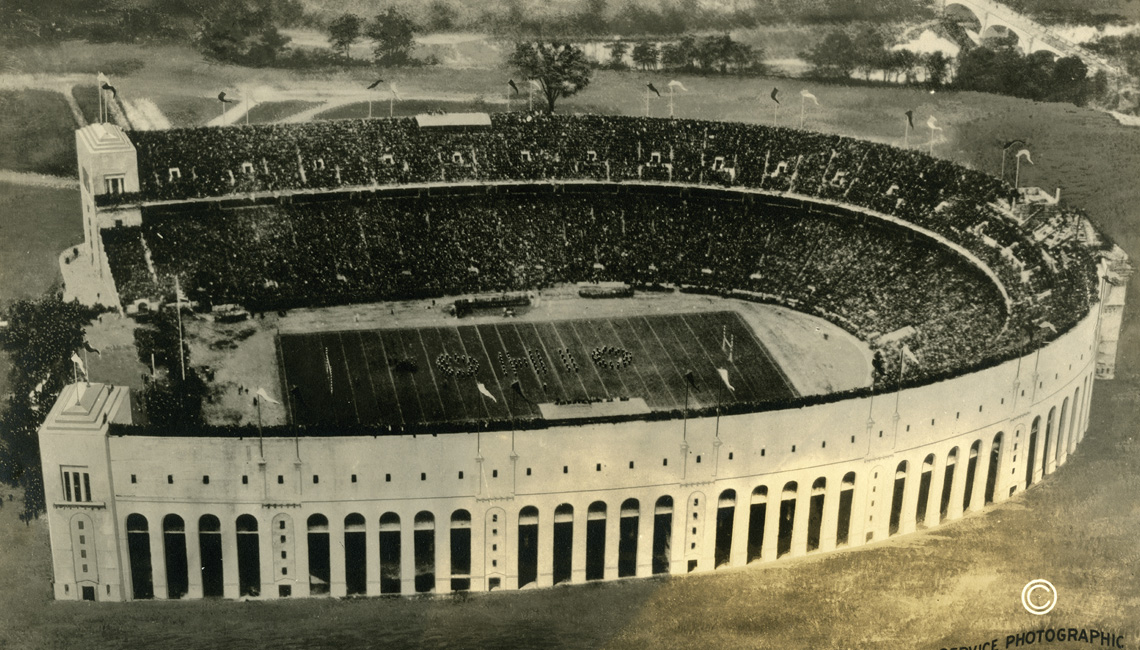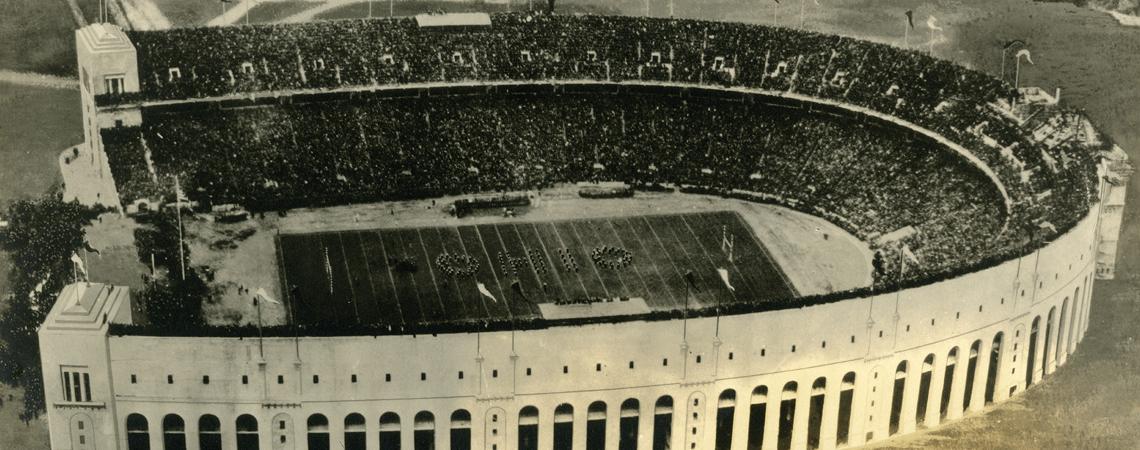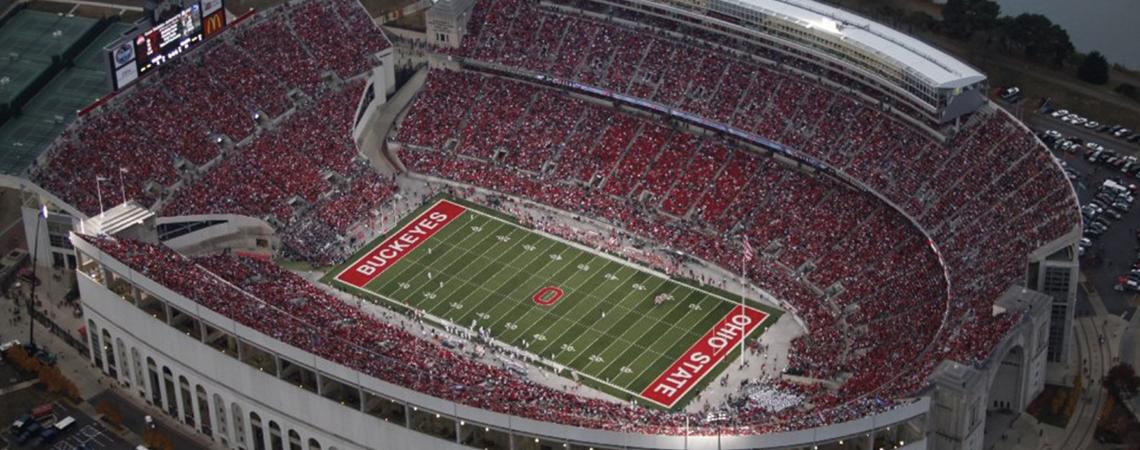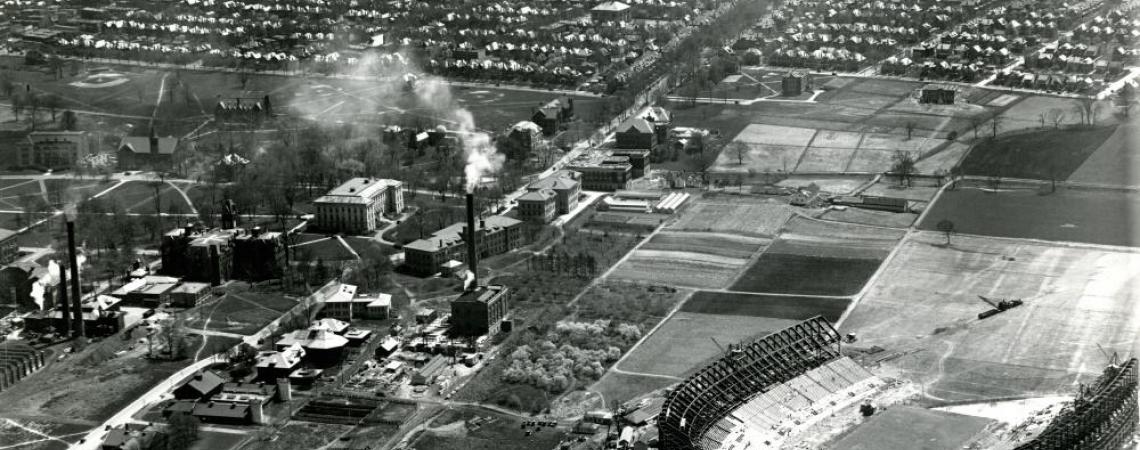These days, as we watch more than 100,000 fans pack Ohio Stadium for Buckeyes football, weekend after weekend each fall, it’s impossible to imagine Ohio State University without it.
The centerpiece of the Ohio State University campus and an iconic image of college football in general, Ohio Stadium turns 100 years old in October. Since its opening in 1922, it is estimated more than 50 million people have been in the stadium for game attendance.
Incredibly, however, according to OSU Head of Archives Tamar Chute, the stadium wasn’t always a given.
The stadium is affectionately nicknamed “the ’Shoe” for its original horseshoe-shaped outline.
“We think, in 2022, that this stadium was inevitable — that it was inevitable it was going to be a double-decker and that it was going to be built for more than 60,000 people [its original capacity]. And of course, we inevitably enclose it because we knew we would fill it up so much, right?” Chute says. “Those assumptions are just not true.”
“There was a lot of debate at the time over this crazy, new, huge building,” Chute says. “Why did we need the stadium? What was its purpose? And why would there be more than 60,000 people coming to watch a game? If you looked at their reasons when they talked about it, they rarely, if ever, mentioned football.”
In fact, the stadium came about more as a result of the world’s geopolitical climate than any success of the football team. “Education was a really important driver at the time, as was physical and military preparedness, because these conversations were taking place right after World War I,” Chute says. “The aftermath of that war really tied into the purpose of the stadium. They wanted it for the entire university, for the overall sense of well-being of the students. They wanted to make it something that people cared about, regardless of whether they cared about football.”
The aftermath of [World War I] really tied into the purpose of the stadium. they wanted it for the entire university, for the overall sense of well-being of the students. They wanted to make it something that people cared about, regardless of whether they cared about football.
A unique design
The stadium is affectionately nicknamed “the ’Shoe” for its original horseshoe-shaped outline. Construction on it began in August 1920, and when completed two years later, it was the largest poured-concrete structure in the world.
Local architect Howard Dwight Smith, an Ohio State alumnus and later a professor of architecture — and eventually the university architect — designed the double-deck style and pioneered new architectural techniques during its construction, such as slurry walls that kept out the nearby Olentangy River floodwaters. When the stadium hosted its dedication game against Michigan on Oct. 22, 1922, it filled its seating capacity of 66,210, leaving an overflow of 5,000 fans to stand. After several expansions, the stadium is currently the fourth-largest on-campus facility in the country, with a seating capacity of 104,581 (though more than 110,000 packed in for the 2016 game against Michigan).
Not just a stadium
The stadium’s history is steeped in memorable moments beyond football. It stands as a witness to the annual spring commencement ceremonies; was the original home of the Columbus Crew Major League Soccer team; and has played host to several mega-concerts such as the Rolling Stones, U2, and numerous incarnations of the Buckeye Country Superfest.
But the ’Shoe is more than just a venue for entertainment and graduation. “Ohio Stadium holds a special place in the hearts of all Buckeyes; it is a place of historic significance,” says OSU President Kristina Johnson. “Families have celebrated a loved one’s academic achievement here, champions have been crowned here, and it has helped so many of us fall in love with what it means to be a part of the Ohio State community.”
A home for students
While it’s a well-known fact that students regularly fill the stadium on game days, the general public might not know that students used to actually live in the stadium. In 1933, the OSU Dean of Men, Joseph A. Park, created the Stadium Scholarship Dormitory for students who otherwise couldn’t afford to go to college.
The scholarship offered students reduced tuition and sleeping quarters inside the stadium in exchange for taking care of dormitory housekeeping chores. The dormitory grew along the west side of the stadium and attracted attention, including a visit from First Lady Eleanor Roosevelt. The program exists today, though because of expansions and renovations, the dormitory moved out of the stadium and into Mack Hall in 1999.
The sense of community and special living circumstances of the Stadium Scholarship Dormitory, however, still resonate with former residents. “Even today, more than 20 years later, I still love to tell people I lived in the ’Shoe and had 95,000 die-hard, screaming Buckeye football nuts in my backyard on Saturdays,” says Jessica (Miller) Banks, a former resident and resident advisor from 1995 to 1997. “I have several close groups of friends that I’m still in contact with on a regular basis. The SSD (Stadium Scholarship Dormitory) was unique in that we all lived and worked there, and having nearly 300 people in your everyday life made a huge campus seem small.”
Celebrating the memories
Ohio State University graduates echo similar heartfelt sentiments about the stadium — even if they didn’t live within its walls. “All my memories of Ohio Stadium are linked to family memories,” says Marcia Dowds, class of ’89. “Going to games with one sister, visiting the other when she lived in the stadium dorms, weekends spent with out-of-town relatives coming in for the tailgates and games. Like a childhood home, the stadium represents some of the best memories of my life in Columbus and my time at Ohio State University.”
Maureen Cahill, class of ’81, summed up her feelings about the stadium, capturing the essence of what the original planners had intended. “When at Ohio State University, everybody wants a chance to be in the ’Shoe and be part of what happens in the ’Shoe — it doesn’t matter what the activity is,” she says. “It could be sports, a commencement, or it could be the Special Olympics. It’s just being part of something bigger than yourself, and that’s amazing.”
All photos used in this article are courtesy of Ohio State University Archives.












